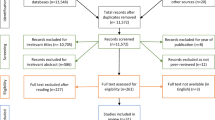Abstract
This paper provides some examples of the utility of graphical methods in analyzing data. While such methods are not expected to supplant standard statistical techniques, they can help the researcher in understanding characteristics of the process in ways that cannot be replicated using the standard methods.
Similar content being viewed by others
REFERENCES
Aird, J. S. (1990). Slaughter of the Innocents: Coercive Birth Control in China, American Enterprise Institute, Washington, DC.
Allen, T. and Buckner, G. (1997). A graphical approach to analyzing relationships between offenders and victims using Supplementary Homicide Reports. Homicide Stud. 1(2): 129-140.
Barnett, A. I. (1982). Misapplication reviews. Interfaces, September-October.
Block, R., and Block, C. R. (1992). Homicide syndromes and vulnerability: Violence in Chicago community areas over 25 years. Stud. Crime-Crime Prev. 1: 61-87.
Cleveland, W. S. (1993). Visualizing Data, Hobart Press, Summit, NJ.
Cleveland, W. S. (1994). The Elements of Graphing Data, Hobart Press, Summit, NJ.
Fisher, R. A. (1992). On the mathematical foundations of theoretical statistics. Reprinted in Kotz, S., and Johnson, N. L. (eds.), Breakthroughs in Statistics, Vol. I. Foundations and Basic Theory, Springer-Verlag, New York.
Fox, J. A. (1998). Uniform Crime Reports [United States]: Supplementary Homicide Reports 1976-1996 [Computer file], ICPSR version. Northeastern University, College of Criminal Justice [producer], Boston, MA. Inter-university Consortium for Political and Social Research [distributor], Ann Arbor, MI.
Hacking, I. (1990). The Taming of Chance, Cambridge University Press, Cambridge.
Hamming, R. W. (1987). Numerical Methods for Scientists and Engineers, Dover, New York.
Loftus, G. (1993). A picture is worth a thousand p-values: On the irrelevance of hypothesis testing in the computer age. Behav. Res. Methods Instrum. Comput. 25: 250-256.
Maltz, M. D. (1994). Deviating from the mean: The declining significance of significance. J. Res. Crime Delinq. 31: 434-463.
Maltz, M. D. (1996). Criminality in space and time: Life course analysis and the micro-ecology of crime. In Eck, J., and Weisburd, D. (eds.), Crime and Place, Criminal Justice Press, Monsey, New York.
Maltz, M. D., Barrett, R., and O'Keefe, J. (forthcoming). Infanticide in the United States (in preparation).
Richters, J. (1997). The Hubble hypothesis and the developmentalists' dilemma. Dev. Psychopathol. 9: 193-229.
Tufte, E. R. (1983). The Visual Display of Quantitative Information, Graphics Press, Cheshire, CT.
Tufte, E. R. (1990). Envisioning Information, Graphics Press, Cheshire, CT.
Tufte, E. R. (1997). Graphical Explanations, Graphics Press, Cheshire, CT.
Vaupel, J. W., Zhenglian, W., Andreev, K. F., and Yashin, A. I. (1998). Population Data at a Glance: Shaded Contour Maps of Demographic Surfaces over Age and Time, Odense University Press, Odense, Denmark.
Wild, C. J. (1994). Embracing the “wider view” of statistics. Am. Stat. 48: 163-171.
Author information
Authors and Affiliations
Rights and permissions
About this article
Cite this article
Maltz, M.D. Visualizing Homicide: A Research Note. Journal of Quantitative Criminology 14, 397–410 (1998). https://doi.org/10.1023/A:1023081805454
Issue Date:
DOI: https://doi.org/10.1023/A:1023081805454




